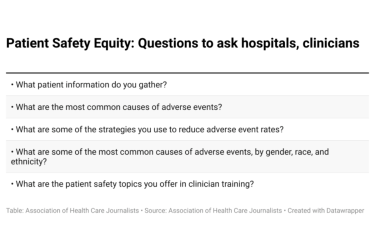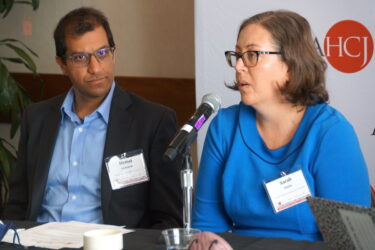Poor children suffer from more dental decay than their wealthier peers. In many cases, they live in communities where oral health services are hard to find. They lack access to the basic preventive care that children from more affluent families take for granted.
 Mary Otto, AHCJ’s topic leader on oral health is writing blog posts, editing tip sheets and articles and gathering resources to help our members cover oral health care.
Mary Otto, AHCJ’s topic leader on oral health is writing blog posts, editing tip sheets and articles and gathering resources to help our members cover oral health care.
If you have questions or suggestions for future resources on the topic, please send them to mary@healthjournalism.org.
Health officials and advocates stress the importance of addressing those disparities, expanding the nation’s public health infrastructure, opening more clinics in poor places.
Researchers into public health challenges have pointed out that whether you are fighting obesity or dental decay, it is harder to grow up healthy in a stressed, dysfunctional neighborhood than in one with amenities that promote well-being.
Better oral health services can help address the oral health problems of the community. But the community is just one ring in a kind of concentric system of factors some experts see as coming to bear upon wellness and disease.
The family is another ring in that system, they say. And new research suggests that the emotional health and educational level of mothers can have a lasting impact upon children’s oral health.
Starting with the oral health of teens and working backwards to age 3, researchers at Case Western Reserve Dental School explored what factors in the children’s past might have influenced their oral health outcomes.
Lead investigator Suchitra Nelson, professor in the dental school, and her team examined the teeth of 224 adolescent participants in a longitudinal study that followed very low birth weight and normal birth weight children over the years. They gathered health and medical information from the children and their mothers to assess the child’s wellbeing at age 3, 8 and now 14. And now they have analyzed the teen’s oral health by counting the number of decayed, filled or missing permanent teeth and have assessed the level of dental plaque, a symptom for poor oral hygiene.
The mothers also completed a questionnaire about preventative treatments including dental sealants and mouthwashes, juice and soft drink consumption, access to dental care and frequency of dental visits.
The data revealed that even with access to dental insurance, fluoride treatments and sealants as young children, it did not always prevent cavities by the age of 14, said Nelson, professor of community dentistry at Case Western Reserve dental school.
She is lead investigator on the Journal of Dental Research article, “Early Maternal Psychosocial Factors are Predictors for Adolescent Caries.”
What did prevent cavities in teens?
Using a statistical modeling program that tracked pathways from the teen’s dental assessments back to the source of where the oral health originated led researchers right to mothers and their overall emotional health, education level and knowledge when children were at ages 3 and 8.
The researchers found if mothers struggled in any of the three areas, the oral health of the teens at age 14 resulted in higher numbers of oral health problems.
“We can’t ignore the environments of these children,” Nelson said. “It isn’t enough to tell children to brush and floss, they need more-and particularly from their caregivers.”
The oral health boost comes from mothers, who muster coping skills to handle everyday stresses and develop social networks to provide for their children’s needs.
It was found that mothers with more education beyond high school, with healthy emotional states and knowledge about eating right had children with healthier teeth.
“We cannot ignore these environmental influences and need interventions to help some moms get on track early in their children’s lives,” Nelson concludes.
Nelson says moms need to care for themselves to help their children. She likens it to the emergency instructions on an airplane that mothers put on the mask first and then their children. “How can a mother help her child if she passes out,” asks Nelson. “It’s all common sense, but some mothers may need help.”
Contributing to this study were Wonik Lee, research associate, and Jeffrey. M. Albert, associate professor from the Department of Epidemiology and Biostatistics and Lynn Singer, Deputy Provost and Vice President of Academic Affairs and professor in the Department of General Medicine and Pediatrics at the Case Western Reserve School of Medicine.
Support for the study came from National Institute of Health’s Institute of Dental and Craniofacial Research and the Health Resources and Services Administration’s Maternal and Child Health Program.









